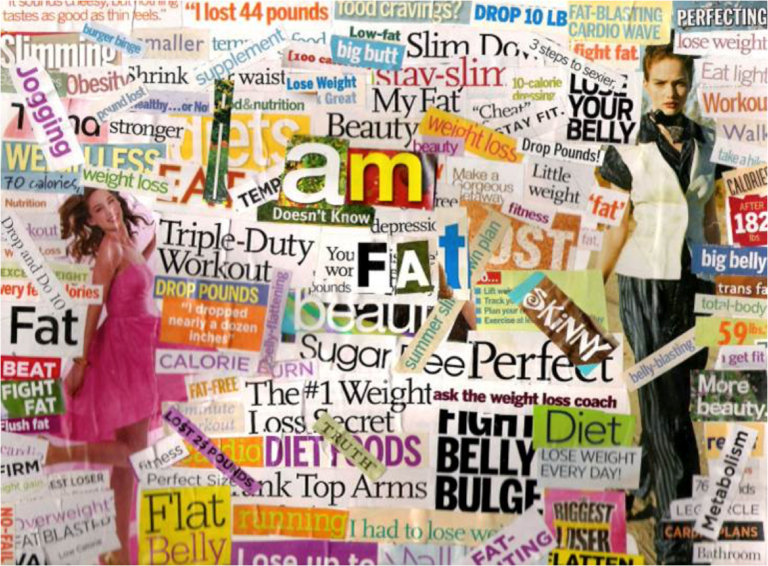Media Today : Unattainable Beauty Standards
Contributed by Cameron Davis
According to a study by the Girl Scouts of America in 2010, out of over 1000 adolescent girls surveyed, 88% of the girls believe that the media puts a lot of pressure on them to be thin and 65% believe that the body image represented in the fashion industry in the media is too skinny, and 60% said they compare their body to what they see in magazines. Now that adolescents have easy access to seeing celebrities on social media platforms like Twitter and Instagram, the pressures have grown. We constantly see these unattainable standards of beauty in the media and it can cause a lot of harm on young girls.
Collage showing harmful messages about body image
The media can cause body dissatisfaction, low self-esteem, and disordered eating. When girls compare their bodies to what is seen in the media, it increases their chance of having a poor body image. Research has shown that media is negatively associated with self-esteem, meaning that the more a girl views the media the greater chance she will have a lower self-esteem. As for disordered eating, research has shown that constant exposure to unhealthy messages about body image is related to disordered eating behaviors, such as restricting food, bingeing, and purging. When young girls see these unhealthy messages, such as the need to have a thigh gap or flat stomach, it can increase their chance of developing eating disorder behaviors in order to obtain these body types. According to a 2015 study by Common Sense Media, teens spend an average of nine hours a day using media (tweens average six hours a day), including movies, television, and social media sites, which means they are getting many hours of harmful media exposure.
Young girls are constantly being subjected to unattainable standards of beauty and the media does a poor job at defining what a ‘normal girl’ looks like. Female celebrities are constantly photoshopped to perfect their bodies by clearing any flaws in their skin and editing their body parts, such as making their waist thinner and their breasts larger.
One of the biggest problems is the lack of diversity seen in the media, which idealizes female celebrities that are white, tall, and thin. This is unhealthy for many young girls of different ethnicities because they are seeing a society that does not represent their ethnicity well in the media. A 2015 study by Laura Romo held a focus group with Mexican American adolescent females to discuss their views on body image and the media. Most of the girls said they were aware that being thin is the standard of beauty as shown by white women in movies, television shows, advertisements, and so forth. And, although many of them admire some of the curvier bodies in the media (some mentioned Beyoncé and Selena), they sometimes still feel pressure of reflecting the mainstream ideal of being thin. One 16-year-old girl in the focus group said “in white culture basically you just have to be skinny. Because you see it on TV, you see it on magazines, you see it everywhere. Everywhere you go, you basically hear that you are supposed to be like that.” If this is what girls of color are seeing in the media, you can imagine how that affects their own body image.
However, there has begun to be a push towards a more diverse standard of beauty, both in body image and diversity in ethnicity. There are brands such as Aerie that have vowed to no longer Photoshop their models because it is about “body positivity and loving your real self.” There are also celebrities speaking out about being photoshopped and about diverse bodies in the media. Danielle
Danielle Brooks during a photo shoot on loving her body
Brooks, known for her role in the show Orange is the New Black, recently called for a change in the media saying, “Ideally, I want to see all beauties, all shapes, all sizes, all skin tones, all backgrounds represented in my profession. Now that I am blessed to be that reflection I was once looking for, I’m making a promise to speak out for that little girl that I used to be.”
Another example of a celebrity speaking out about body image is actress Gina Rodriguez. In an interview, Gina said she learned body image positivity from her father saying, “he prepared us to be able to look at billboards and magazines and say, ‘this is not the only body type that is beautiful.’ He would encourage us to find our beauty and accept our beauty as what God gave us.”
It is important for young girls to seek out these body positive celebrities so that they understand that beauty is being yourself and accepting yourself.


